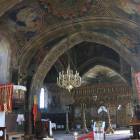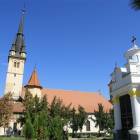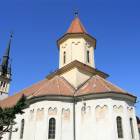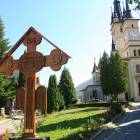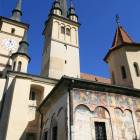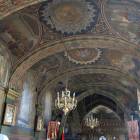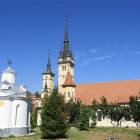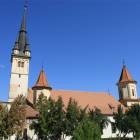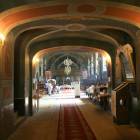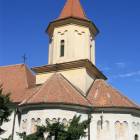Saint Nicholas Orthodox church in Brașov, a monument dating from 1292
Though the Black Church in downtown Brașov is the most famous monument in the city, there is another religious building, not far away, that is about one century older: the Orthodox church of Saint Nicholas. Compared to the massive and grim Evangelical Black Church, the Orthodox church is slimmer and covered in Byzantine frescoes on the inside. But borrows a lot from the Gothic style, with its tall and thin spires, unusual for an Eastern church.
On its premises, in the last years of the 15 century was founded the oldest Romanian school, building that can still be visited today.
The church was the gathering point for a vibrant Romanian community that lived outside the walls of the fortified German city of Brașov. Today engulfed in the large modern city of Brașov, this neighborhood, known as Șcheii Brașovului, is still distinct because of its traditional houses with vegetable gardens, where Romanians and Bulgarians have lived for centuries.
The shape of the church dedicated to the great theologian Saint Nicholas has changed over the centuries. In 1292 here was not much than a wooden cross and some wooden small building for the parish to gather. It was completed with a brick construction and, in the end of the 15th century, the impressive building we see today, after several renovations and additions.
In the tradition of the ties between Romanian communities over the Carpathians, some important kings from the Romanian County (Wallachia, the southern part of today Romania) contributed to the building of this edifice. The founder of the new stone church was Neagoe Basarab, followed by his descendent, Petru Cercel. Important donations were made by princenss Ancuța, the daughter of Constantin Brâncoveanu, but also by Elisabeth, the empress of Russia.
The iconostasis displays the style of Constantin Brâncoveanu, while much of the frescoes are made by Costin Petrescu. The artist who painted much of the interior of the Romanian Atheneum in Bucharest continued his national program, very important for the 20th century Romania, between the two world wars. National figures, such as king Michael the Brave, the first unifier of Romanian provinces, or king Michael I, the last Romanian monarch of the 20 century, are represented in frescoes along with traditional biblical episodes.
Mai multe despre: Religious architecture, Romania • Brasov • Costin Petrescu • iconostasis • Neagoe Basarab • Orthodox architecture • Romania • Saint Nicholas • Transylvania- Home Page
start page - Architecture
landmark buildings - Sacred architecture
places of worship - Nature
landscape photography - Concert
performing artists - Christmas
Santa Claus pictures
- Jooble
jobs for photographers - Escape
an out of control blog - Merry Christmas
The best organizer of Christmas parties - Astro photo
Eclipse hunting and astrological photography

